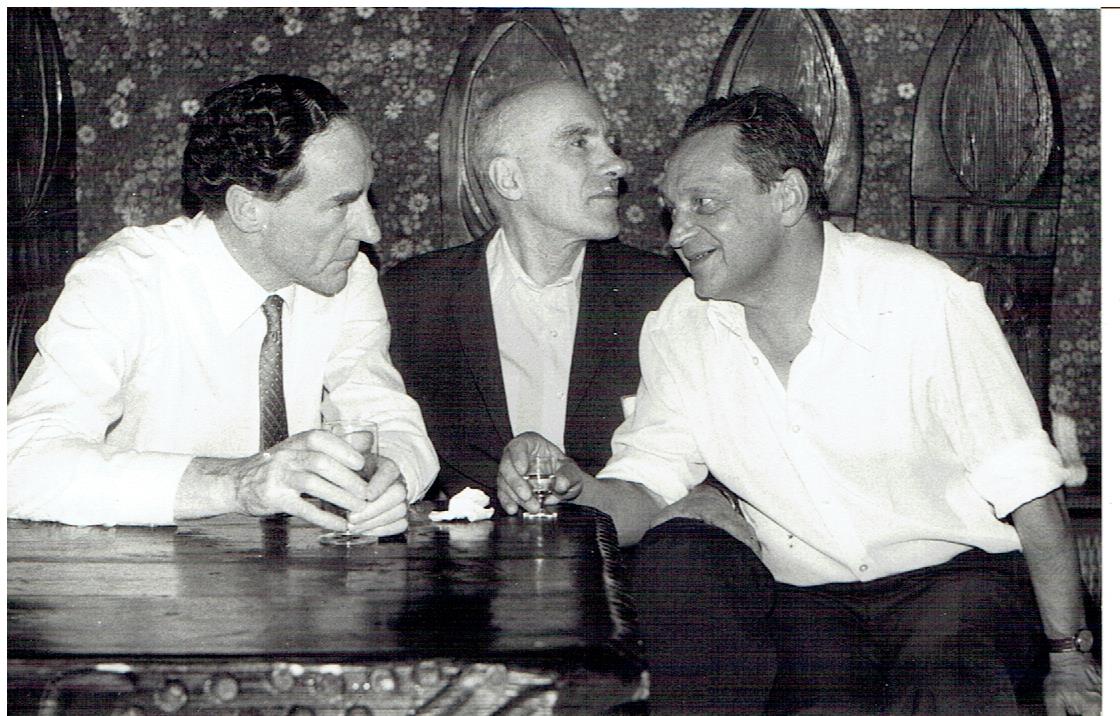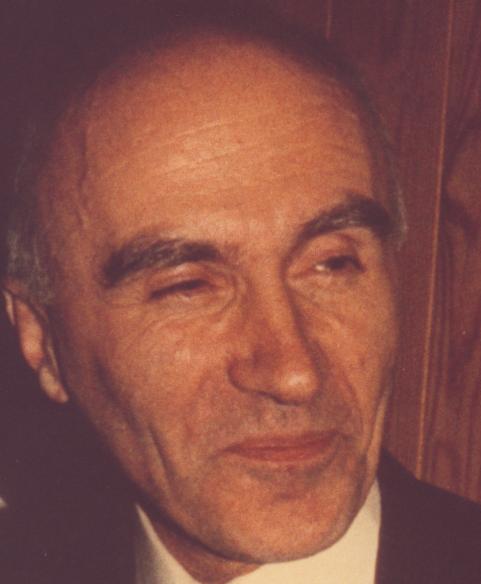WLADYSLAW FISZDON
1912-2004
On 25 October 2004 Professor Wladyslaw (Wladek) Fiszdon, an outstanding scientist, aerodynamist, aviator and mathematician died in Warsaw. Polish Science has thus suffered a painful loss and all who knew him lost a close friend, a man of extraordinary mind and character. In his last days he was accompanied by friends, colleagues, students from the numerous institutions he worked in. Everything that he has done for the Polish Science, especially for the development of the Fluid Mechanics in Poland, will remain forever in our memory and in the memory of future generations.
Wladyslaw
Fiszdon was born on 12 June 1912 in a poor peasant family in Kozin (in the
Wolyn region). He attended secondary school in Dubno, where he passed his
baccalaureate in 1930. In school he already distinguished himself by his
fondness and talent for the exact sciences. Therefore Stanis³aw Kobierski, a
priest working in that school helped him receive a scholarship and begin
mathematical studies in the Science Faculty at the Sorbonne University in
Paris. After having graduated with a bachelor’s degree from the Sorbonne in
1933 Wladyslaw Fiszdon transferred to Ecole Nationale Superieure de l’Aeronautique, where he obtained a diploma of
Engineer of Aeronautics. He then decided to
return to Poland to begin working in the Institute of Aviation in Warsaw
and in 1936 he moved to Lublin, where he found employment in a construction
bureau of the Lublin Aircraft Plant. Two years later he married Kamila
Zielonka. In spite of it being a very happy marriage fate drew them apart only
a year after their wedding. When World War II broke out on 1 Septemeber 1939,
on 2 Septemeber the Lublin Aircraft Plant became the target of German bombing.
The decision to evacuate and move near the Romanian border was finally
undertaken by Wladyslaw Fiszdon, and when the Soviet troops transgressed the
Polish borders he along with other factory workers found his way to Romania,
and from there through Belgrade and Athens he journeyed to Marseille in October
1939. Thus the war divided the Fiszdon marriage. A few months later Kamila gave
birth to a son in Poland, but only in 1946 after the war she was lucky to
rejoin her husband.
In December 1939
Wladyslaw Fiszdon obtained work in a construction office in an aircraft factory
- Devoitine in Toulouse. However, he worked there only until May 1940. When the
German army invaded France he managed to escape to Great Britain, where he was
engaged in the Royal Aircraft Establishment in Farnborough. There as a Senior
Scientific Officer he turned his attention to the problems of flatter
vibrations and dynamic loading in order to modernize and improve British
fighter planes. Despite having the perspectives to advance professionally in
Great Britain Wladyslaw Fiszdon declined this opportunity and returned to his
homeland on 21 March 1946, where he was awaited by his wife and son Jerzy.
On
1 May 1946 he began working as the Deputy Director for Scientific Research in
the
Aviation Institute in Warsaw, where he worked until 1957. In the Institute
Wladyslaw Fiszdon directed the construction and the building of the
experimental research base, the aerodynamic subsonic and supersonic tunnels,
engine examining stations and other devices to examine aircrafts. In February
1947 he was offered to deliver lectures on flight mechanics and aircraft
aerodynamics at the Warsaw University of Technology. Wladyslaw Fiszdon embarked
on a prolific academic career while continuing his work at the Aviation
Institute. In 1951 he defended his Doctoral Dissertation from Aerodynamics at
the Warsaw University of Technology, five years later he became professor
extraordinarius and in 1962 he received the position of professor ordinarius.
In 1960 he was appointed as member-correspondent and in 1969 as member of the
Polish Academy of Sciences. Between 1981 and 1983 he was a member of the
Presidium of the Polish Academy of Sciences.
At
the Warsaw University of Technology, where he worked from 1947 until 1970 he
organized and headed the
Department of Flight Mechanics at the Aviation
Faculty. He was also the vice dean of the Aviation
Faculty and from 1960 until
1963 the first dean of the newly established Faculty of Mechanics, Energy and
Aeronautics. From 1955 until 1982 he worked and from 1961 until 1980 he headed
the
Department of Fluid Mechanics
in the
Institute of Fundamental Technological
Research.
He was the chairman of the Scientific Council in the Institute of
Fundamental Technological Research from 1981 until 1983. In the years of 1970
to 1982 he was a professor of Warsaw University at the Faculty of Mathematics
and Mechanics, where he acted as the Director of the Institute of Mechanics
from 1977 until 1981. Moreover, he was the vice rector of Warsaw University. In
1982 he retired yet remained very active in scientific work.
Professor
Fiszdon was a member of numerous international scientific societies. In 1959 he
was appointed to the Royal Aeronautical Society in London and to the American
Institute of Aeronautics and Astronautics (AIAA), and in 1960 to the
International Academy of Astronautics, which was established the same year in
Stockholm. In 1980 he participated in the General Assembly of the International
Union of Theoretical and Applied Mechanics (IUTAM), and in 1986 he became a
member of the American Physical Society (New York).
Professor
Fiszdon received his aviation engineering education in France whilst he
obtained his exceptional professional experience during the war in Great
Britain. These international relations from his youth and his fluency in
foreign languages facilitated his international cooperation during the times
when for political reasons authorities restricted relations with Western
countries. In 1957 Professor Fiszdon went to the USA, where he worked as Guest
Professor at the Massachusetts Institute of Technology. There he focused his
research on the interaction between the oscillatory
shock wave and the boundary
layer and he ascertained that investigating this problem within the continuous medium approach is not appropriate
in certain areas. This work marked the beginning of his interest in Statistical
Physics. Thus he moved away from examining fluid mechanics of continuous media
and he concentrated his attention on the problems of flows in rarefied gases.
This field was the object of his activity for many years and it gave rise to a
great number of influential publications. Apart from Professor Fiszdon's
unquestionable knowledge, his devotion and enthusiasm for teaching and for the
subject itself was valued by many. He
numerously visited the MIT, as well as other scientific centers in the USA such
as the California Institute of Technology, the University of California,
Cornell University, University of Notre Dame (Indiana). He was also a frequent
guest of Universite de Paris, Cambridge University (UK)
and the Max-Plank Institute für Strömungsforschung in Göttingen (Germany).
In 1982 Professor Fiszdon retired. This was the time of martial law in Poland with all its painful consequences. His close colleague dr Ryszard Herczynski was arrested, which caused Professor Fiszdon to be frequently interrogated by the security services and deprived him of normal conditions for scientific work. His attention veered toward a new interest - the mechanics of superfluid helium, along with a special fascination for the problems of quantum fluids. Professor Fiszdon's significant achievement was the theoretical representation of results of experimental research on influence of quantum turbulence on the evolution of moderate second-sound heat pulses in superfluid helium. At this time he cooperated closely with scientists performing experiments by participating in research planning. The fruit of his fascination with the mechanics of liquid helium are his formidable publications on this matter. Considering the fact that Professor Fiszdon has written about a hundred scientific articles in his life, the number of articles published in the last decade of his scientific career constitute one third.
Unfortunately,
this intense activity was interrupted due to health problems in May 1994 and
followed by ten years of a determined fight with the sickness. However, his
spirit, passion for work, and unsatisfied thirst for knowledge has made a
permanent impact on his colleagues and disciples and along with his scientific
contributions will continue to shape the future generations.
Prepared by A. Zachara and T.A. Kowalewski
Warsaw,
Dec. 15, 2004
See also an extended obituary in Archives of Mechanics
